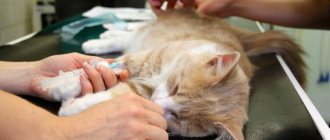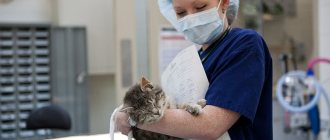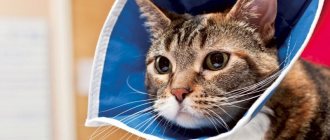The peculiarities of city life dictate its harsh conditions to people and animals. Naturally free animals are locked in apartments, and instead of hunting, they imposingly chew dry food. But no metropolis can cancel the laws of nature, and pretty soon yesterday’s kitten begins to demand a female.
Thus, pet owners often have to face the forced need to castrate a cat in order to avoid many problems with the pet’s behavior: increased aggression, the fetid smell of “marked territory” and puddles in the most unexpected places, litter.
Sterilization and castration of cats
Often, cat owners confuse two inherently different concepts: “castration” and “sterilization,” naively believing that castration is “when the bells are cut off for cats,” and sterilization is the same as castration, only in cats. Both of these procedures can be performed on both male and female cats. Neutering a cat involves either ligating the ovaries or removing the uterus while leaving the ovaries. A cat can “flow”, experience urges and still make love to the cat, however, without the threat of becoming pregnant. Well, it’s just like with people.
Castration of a cat involves removing both the uterus and ovaries. After this procedure, cats do not go into heat, hormones do not fluctuate, the risk of cancer is reduced, and the function of the ovaries is transferred to the adrenal glands.
How to determine when it's time?
Cat owners most often turn to castration of their pet after much deliberation. But a decision must be made even before the little robber appears in the family.
- If an animal is purchased as a pet and has no breeding value, then it must be castrated as planned, upon reaching the age of nine months;
- it’s time to make a decision about an unplanned orchiectomy even if the animal constantly marks its territory, shows aggression towards household members, if the threat of escaping from home is real;
- Another reason for castration may be a tumor on the testicles, which must be removed.
Expert opinion
According to experienced veterinarians, castration is considered quite simple and does not have any negative consequences. However, if a more mature cat has to be castrated, then anesthesia during the operation can play a decisive role. The health of an old animal is much weaker than that of a young one. Based on this, there is a risk that it is worth noting again that any complications may occur during the process of the pet recovering from anesthesia. In general, today there are few veterinarians who oppose castration of cats.
Sterilization and castration of cats
Castration of a cat means deprivation of furry testes. There is no need to assume that castrated cats are deprived of all the joys of life. On the contrary, after castration, the chances of dying from urolithiasis (UCD), which occurs in many cats due to hormonal fluctuations and metabolic disorders, are sharply reduced. Operated purrs live much longer than their relatives due to the stability of hormonal levels, they no longer suffer from sexually transmitted infections, and their behavior improves.
Sterilized cat - with spermatic cords tied. The method is controversial, because after this procedure the cat continues to mark the territory and your shoes, and is able to hunt cats without procreation. It is a mistake to think that a sterilized cat suffers from the inability to procreate and lack of sex. After all, even in the wild, the male still has to win his right to the female, and not everyone succeeds in this.
Surgical castration
Before the operation, the animal is brought to the clinic in advance, the doctor is told about chronic diseases, previous operations, and contraindications to anesthesia are excluded. Blood is taken from the cat for biochemical analysis to identify hidden pathologies. Additionally, representatives of breeds predisposed to hypertrophic cardiomyopathy are examined: Maine Coons, Sphynxes, British cats, Scottish folds, bobtails.
Preparing for surgery
On the day of castration, the veterinarian examines the cat: measures temperature, pulse, blood pressure, feels the stomach and lymph nodes, and checks the mucous membranes of the mouth. Based on the results of the visual examination, he recommends an ultrasound of the heart, abdominal organs, and an electrocardiogram.
A veterinary surgeon prepares instruments:
- injection syringes;
- abdominal scalpel;
- tweezers;
- clamps;
- tampons;
- surgical needles;
- needle holder;
- surgical scissors;
Instruments are sterilized in an alkali solution for a quarter of an hour.
Anesthesia
Cats are castrated under general anesthesia, their muscles relax, sensitivity to pain disappears, and consciousness turns off.
Drugs are administered using the following methods:
- Parenteral. Medicines are given intravenously or intramuscularly. In the first case, the operation begins after 2 minutes; if the dose is calculated correctly, the effect lasts 15–20 minutes. This time is enough for the operation; the anesthetic does not have time to deeply affect the respiratory and cardiovascular systems. When administered intramuscularly, the effect of the drug begins after 5–10 minutes, the recovery after anesthesia lasts longer. This method is used for excitable animals.
- Inhalation . Narcotic gas is supplied to the lungs through an endotracheal tube or mask, it penetrates into the blood and causes deep anesthesia. After the procedure, the gas is eliminated through the lungs, and the liver eliminates the remaining gas. This method is safer, but more expensive. The equipment is found only in large clinics.
Local anesthesia for castration of cats is rarely used. The animal is first immobilized, then the incision site is injected with analgesics.
Progress of the operation
The procedure consists of three stages:
- Preparation of the surgical field . Doctors shave or pluck the hair on the scrotum, wash it in a soapy solution to remove fatty secretions, and treat it with antiseptics: iodine or ethyl alcohol.
- Removal of testes . The skin is cut with a scalpel, the testis is separated from the vaginal membrane, and it is removed from the incision. To stop bleeding, two methods are used: divide the spermatic cord into 2 parts and tie it into biological nodes or apply a ligature or surgical thread. Then the testis and part of the cord are cut off.
- Treatment of the wound . The incision site is disinfected with an antiseptic, but is not sutured so that the inflammatory exudate can drain freely.
After the operation, the doctor measures your blood pressure, listens to your heartbeat, and if he finds no abnormalities, he sends you home. Owners are advised to stay in the clinic for 20 minutes, observe the animal, and return to the doctor in case of bleeding or other problems.
Preparing for surgery
Having decided to undergo surgery, owners must clearly understand that castration is a surgical operation that requires adherence to a clear algorithm of actions. Having chosen a suitable veterinary clinic, before the operation it is necessary to take tests: blood, urine, a smear for sexually transmitted infections, and give the cat a cardiogram. Get vaccinated in advance, about two months in advance, or you can postpone them for a while.
It is important to approach the operation responsibly and not spare money on procedures and examinations, because the health and life of your pet depends on its successful implementation.
After anesthesia, the cat will sleep for several hours, so you need to take a carrier and a blanket to the veterinary clinic; during narcotic sleep, the body temperature drops and the pet may freeze.
When should a kitten be spayed or neutered?
Experts recommend spaying or neutering kittens at 5-7 months of age, but not earlier than 8 weeks. At 5-7 months, kittens are already large enough for surgery and tolerate anesthesia well. The operation can also be performed on cats during estrus.
Adult animals can be spayed and neutered. In most cases it is safe. Before the operation, you need to consult a veterinarian - you may need to undergo tests. But if the pet is healthy, then the operation is not dangerous even at an older age.
FAQ
The upcoming operation raises some questions among the owners:
- Is it possible to feed a cat before surgery or how much not to feed before surgery? Before castration, the cat should not eat for at least 12 hours. It is better to endure anesthesia on an empty stomach; the possibility of vomiting and diarrhea after the procedure is also reduced. You can give your cat something to drink a couple of hours before castration.
- Is it possible to sterilize a cat without castration? Yes, it's possible. But this method is half-hearted. After sterilization (ligation of the spermatic cords), the tailed cat can continue to mark the territory and jump on the female, especially if the cat is “experienced” and has previously had experience in loving communication with cats.
- What is preferable: spaying or neutering a cat? It is worth noting that not all clinics carry out sterilization of cats, therefore, if you really want to sterilize (ligate the spermatic cords) of your pet, then be prepared to look for a suitable veterinary clinic and fork out some money.
How does the operation take place?
The operation can be performed either in the clinic or at the owner’s home, there is no fundamental difference. The whole procedure takes only a few minutes. Anesthesia is administered (intramuscular or intravenous). Next, the surgical field is disinfected, in our case it is the groin area. Then the scrotum is incised longitudinally to the size of the testis. The doctor removes the testis from the scrotum and tightens the spermatic cord (applies a ligature). The testis is cut off.
How to care for your pet after surgery?
After castration, blood stains and clots must be removed from the incision site once and sprinkled with an antiseptic. During the first 24 hours after surgery, the cat's condition should be closely monitored. After anesthesia, the fluffy can sleep for several hours, but after waking up he remains in an intoxicated state for some time, poorly coordinates his movements, refuses to eat, but wants to drink. For a couple of days you need to help the cat get to the toilet. Because it still hurts to move after castration. It is better not to fill the tray, so as not to expose the fresh suture to the risk of infection and decay; in extreme cases, you can put an absorbent sterile towel there. It is necessary that the cat does not lick or scratch the surgical suture. Veterinarians recommend treating the wound with brilliant green only in the area around the seam. If the suture does not heal within a few days, contact the operating veterinarian.
What should I feed my cat after surgery?
Many cat breeders criticize castration because the cat allegedly gets fat after it. But animals, like humans, gain excess weight due to poor nutrition. The menu after surgery can be simple but balanced. Boiled poultry, beef, cottage cheese, occasionally eggs, vegetables, drink plenty of fluids. If your cat is used to eating only cat food, then you should not forcefully change his diet, but reduce the portion slightly to avoid overeating. Yes, the cat will not overeat, scream heart-rendingly and demand a partner, because hormones no longer require release, and therefore no energy is wasted.
What should cats not be fed after surgery? Neutered cats are practically no different from all other cats (well, except that there are no tiny testes). Therefore, on a general basis, we do not feed food that is too fatty, salty, carcinogenic, smoked (which we ourselves love to eat), food of dubious quality, and legumes. We give exactly as much food as we gave before the operation.
Does a castrated cat live less?
As already mentioned, castrati are practically no different from others of their own kind. And life expectancy is influenced by sufficient physical activity, timely vaccinations and treatment, a balanced diet, a favorable home environment, and the absence of small children pulling the tail.
What is castration
Castration is a medical procedure that suppresses sexual instincts.
There are two methods used in veterinary medicine:
- Surgery. Under general anesthesia, the scrotum is incised and the testes are removed. After the procedure, the hormonal background changes, the concentration of testosterone gradually decreases. The animal's reproductive instinct is suppressed, interest in females disappears, and behavior changes.
- Medical castration . This method does not require anesthesia or surgery. An implant is inserted under the skin, the active substance is gradually absorbed, reducing the level of testosterone in the blood. The effect appears 6 weeks after administration and lasts from 6 months to a year.
The first method suppresses sexual instincts for life, the second method suppresses temporarily, but is suitable when anesthesia is contraindicated.
Why castrate a cat?
During puberty, the testes descend into the scrotum and produce the sex hormone testosterone. Under its influence, the reproductive instinct awakens, which subordinates behavior.
Domestic cats in city apartments fail to realize their instincts, so they are in a state of constant tension, become irritated, and aggressive. Against the background of stress, metabolic processes are disrupted and immunity decreases.
Random matings will not improve the situation, because testosterone is constantly produced. According to veterinary standards, a male needs to be bred every 2 to 3 weeks to keep him healthy. The only way out is to reduce the amount of testosterone in the blood, which is possible only after castration.
Surgical intervention will be required for pathologies of the testes: cryptorchidism, malignant tumors, inflammations that cannot be treated with medications.
Advantages and disadvantages
Hormonal changes after surgery have a positive effect on the cat’s health, psyche, and behavior, and the life of the family becomes calmer:
- The pet does not leave marks, and the unpleasant odor disappears from the apartment.
- Stops screaming for the cat.
- Becomes balanced, aggression towards surrounding people and animals disappears.
- Doesn't jump out the window, risking breaking.
- Does not run away from home to the street, where dangers lurk: cars, dogs, cruel people.
- Does not get into fights with other males.
- Does not become infected with dangerous infections during uncontrolled mating or contact with street animals.
- The likelihood of prostatitis, tumors of the paraanal glands, and prostate adenoma is reduced.
- Life expectancy increases by 1.5 - 2 years.
After the procedure, undesirable consequences are also discovered:
- The cat's mobility decreases, metabolism slows down, which causes an increase in body weight. Habitual food portions are reduced by a quarter, and daily feeding standards are strictly followed to prevent obesity and the development of cardiovascular pathologies.
- With urolithiasis, the likelihood of blockage of the urethra with sand increases. The owner will have to switch the pet to food to prevent the formation of deposits in the bladder.
- Under the influence of anesthesia, the rhythm of the heart and breathing slows down or speeds up, blood pressure increases or decreases, temperature drops, these changes worsen the physiological state. The probable risks of anesthesia depend on the qualifications of the doctor.
Adverse consequences do not occur if the animal is fed properly and thoroughly examined before the procedure.
Is it necessary to neuter a cat at all?
If you have the opportunity to find a female at the first demanding “meow!”, if you are already accustomed to the pungent smell of cat marks and torn wallpaper, if there are many kind hands around you who will happily sort out the offspring, or if you have a ruthless heart and You can drown kittens if the feeling of solidarity keeps you up at night. If you are not afraid that a domestic cat will find someone on the street to satisfy its basic instinct and contract some kind of feline gonorrhea from her, then, of course, you should not do this. You decide. But city life dictates its own conditions to cats, city conditions, which, by the way, are also cruel.
We recommend reading: How to properly care for a cat after castration?
Features of anesthesia, description of types of anesthesia
An important point in the operation is anesthesia. For certain health problems, such as diseases of the cardiovascular system, it is preferable to use local anesthesia. It does not put as much stress on the animal’s body as the general one.
But with local anesthesia, despite the lack of sensitivity in the operated area, additional fixation of the pet is necessary. No cat will like such manipulations. If the animal is young and strong, general anesthesia is chosen. If used correctly, it will not have any negative impact. Before choosing one or another type of anesthesia, you should provide your veterinarian with information about the cat’s past illnesses and chronic diseases.
Methods of administering anesthesia:
- Intravenous. Most often used. The optimal effect is achieved very quickly, due to blood circulation throughout the body. The animal easily recovers from such anesthesia.
- Intramuscular.
- Inhalation. Equipment for such administration of anesthesia is not available in every veterinary office. That is why this method is used quite rarely.
Postoperative care
It is easier to care for your pet after local anesthesia. The main difficulty is to eliminate the effects of stress, you can give a treat, pet the pet, hold it on your lap. Then all that remains is to properly treat the wound. The following procedure should be carried out daily, or preferably 2 times a day:
- First you need to clean the wound with a damp swab to remove large pieces of dirt.
- We treat the wound with an antiseptic.
- Place a bandage on top.
Taking care of the wound is considered a significant factor in recovery, but a pet can touch and tear the stitches or damage them in other ways. For this reason, it is necessary to wear an Elizabethan collar and a blanket over the stomach. It should be worn after castration for about 4-6 days.
In addition, you must not forget about the possible negative consequences, and be ready to go to the doctor again at any time. This should be done in case of sudden changes in temperature, changes in the shade of mucous membranes, swelling, heart murmurs, or difficulty breathing.
Nutrition for castrated cats
After a certain period, the cat’s behavior and actions change, often the pet becomes more gentle and balanced, and is less drawn to the street. At the same time, hunger increases; this fact must be looked at especially carefully, because neutered pets are predisposed to obesity.
To balance energy metabolism, the number of calories is reduced by 25-30%. Fish is excluded from the diet, the supply of dry food is reduced or abandoned altogether. You also need to avoid fried, salty and fatty foods. You can feed them with porridge, boiled lean meat or special food for castrated animals.
General information
In addition to sperm, the testes secrete male hormones, so the cessation of their activity leads to a number of irreversible consequences:
- Animals become calm, aggression disappears.
- External signs characteristic of females develop.
- When castrated at a young age, the cat becomes lethargic and voracious.
- The animal becomes more tame.
Why is castration necessary?
Castration of cats is recommended for economic and aesthetic purposes:
- Cats stop marking their territory.
- Sexual desire is eliminated.
- They become less aggressive and pugnacious.
- They become more affectionate.
- They do not suffer from many “male” diseases: prostatitis, prostate cancer.
Castration is mandatory for therapeutic and preventive purposes in case of:
- Testicular cancer.
- Orchitis.
- Damage to the scrotum, testes, epididymis.
Contraindications to castration
Surgical, as well as chemical, biological, physical castration is contraindicated in a number of cases:
- exhaustion of the body;
- age up to 7 months;
- cardiovascular diseases;
- lung diseases;
- time 2 weeks before vaccination;
- two weeks after vaccination.
Anatomy of the genital organs
The actual genital organs of cats are represented by the penis and testicles. The testicles consist of testes with appendages and the scrotum - a skin-muscular sac in which everything is located.
Scrotum
In cats, the scrotum is an unpaired sexual organ, which is divided into two parts only internally by the median septum. From the outside, the septum is visible in the form of a depression, which is called a suture or median groove of the scrotum.
In cats, the scrotum is located behind the hips and pelvis, near the anus. It has a cervix, the tapering part of the scrotum that meets the abdominal wall. As well as the head or main part, which actually forms the spherical shape of the scrotum.
Despite the apparent simplicity of the “bag,” it has a rather complex structure. There are several membranes in the scrotum, which are important to know when analyzing castration methods:
- Leather. On the scrotum it is thin and flexible, thanks to which it simply stretches. The dermis contains hair follicles, sebaceous and sweat glands. The subcutaneous fat layer is absent.
- Muscular-elastic membrane. Lines the skin of the scrotum from the inside instead of subcutaneous fatty tissue. Its basis is connective tissue, which is penetrated by a large number of elastic fibers and smooth muscles.
- Fascia of the scrotum. Covers its entire internal surface. On the outside, it is loosely connected to the muscular-elastic membrane. The inside is also loose - with the common vaginal or with the external levator testis.
- The external levator is the fibers of smooth muscle tissue that cover the fascia only partially, not reaching the median septum, and often line the fascia only from the side of the neck of the scrotum.
- Common tunica vaginalis. Created by fibrous and serous sheet. Covers the fascia of the scrotum and external levators. The common tunica vaginalis forms the common vaginal cavity and canal, which communicates with the abdominal cavity through the inguinal opening.
- Special vaginal membrane. It is a continuation of the peritoneum; it covers the outside of the testis. Together with the common vaginal cavity, it forms the common vaginal cavity and canal.
Testis and epididymis
The testis in cross section has the shape of an oval. Its basis is connective tissue, which forms the outer frame and internal partitions. Sperm mature in these chambers.
The testicular appendage is also created by connective tissue; it consists of a flat oblong body, a thick head and a narrowed part - the tail. The body and head are attached to the testis. The tail passes into the vas deferens.
The spermatic cord is the mesentery of the testis and epididymis with small inclusions of connective tissue. The spermatic artery and vein, lymphatic vessels pass through it, while nerves, the internal elevator and the vas deferens pass through the cord. In the testis, the artery creates a large number of convolutions, their function is to regulate pressure.











